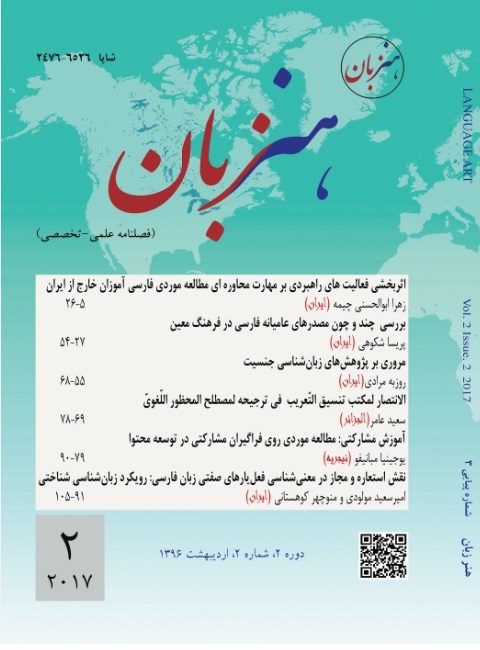نقش استعاره و مجاز در معنیشناسی فعلیارهای صفتی زبان فارسی: رویکرد زبانشناسی شناختی
DOI::
https://doi.org/10.22046/LA.2017.10کلمات کلیدی:
فعلیار صفتی، نظریۀ استعارۀ مفهومی، مجاز.چکیده
در مقالۀ حاضر، برحسب نظریۀ استعارۀ مفهومی یک طبقهبندی معنایی از فعلیارهای صفتی زبان فارسی ارائه میگردد: فعلیارهای صفتی که نشاندهندۀ چرخش استعاری هستند و فعلیارهای صفتی که فاقد چرخش استعاری هستند. استعارههای مربوط به زیرطبقۀ نخست بهوسیلۀ نوع خاصی از مجاز مفهومی تحتعنوان معلول بهجای علت برانگیخته میشوند. زیرطبقۀ دوم هم شامل فعلیارهایی هستند که ترکیب آنها با همکرد، نشاندهندۀ هیچگونه چرخش استعاری نیست. پساز شناسایی دو فرایند شناختی مذکور در شکلگیری معنیشناسی فعلهای مرکبی که دربردارندۀ فعلیارهای زیرطبقۀ نخست بودند، ماهیت ترکیبی معنای این فعلهای مرکب شناسایی شد و دو معنای جدید برای همکرد «کردن» در زبان فارسی معرفی گردید: «شدن» (غیرعمدی) و «باعث ایجاد یک ویژگی/حالت در خود گردیدن» (عمدی). یافتۀ دیگر مقالۀ حاضر معرفی «پیدا کرد» بهعنوان نخستین همکرد دوکلمهای زبان فارسی است.
مراجع
Bateni, M. R. (1989). farsi zabani aghim? Adine. 33, pp. 66-71.
Dabir-Moghaddam, M. (1997). Compound verbs in Persian. Studies in the Linguistic Sciences. 27(2), pp. 25-59.
Folli, R., H. Harley and S. Karimi. (2005). Determinants of event type in Persian complex predicates. Lingua. 115(10), pp. 1365-1401.
Ghomeshi, J. and D. Massam. (1994). Lexical/Syntactic relations without projection. Linguistic Analysis. 24, pp. 173-217.
Golfam, A. and F. Yusefirad. (2002). zabanshenasi-ye shenakhti va este’are. Tazeha-ye Olum-e Shenakhti. 4(1), pp. 59-64.
Karimi, S. (1997). Persian complex verbs: Idiomatic or compositional. Lexicology. 3, pp. 273-318.
Karimi-Doostan, Gh. (1997). Light verb constructions in Persian, Ph.D. Thesis in General Lingustics, Essex University, England.
Karimi-Doostan, Gh. (2008). Predicative nouns and adjectives. Dastoor, (3), pp. 187-202.
Khanlari, P. (1973). tarikh-e zaban-e farsi. Tehran: Bonyad-e Farhang-e Iran.
Kövecses, Z. (2010). Metaphor: A practical introduction. Oxford University Press.
Lakoff, G. (1987). Women, fire and dangerous things: What Categories Reveal about the Mind. University of Chicago Press.
Lakoff, G. (1993). The contemporary theory of metaphor. In Metaphor and Thought, Eds., Ortony, A. Cambridge University Press, pp. 202-251.
Lakoff, G. and M. Johnson. (1980). Metaphors we live by. University of Chicago Press.
Lakoff, G. and M. Johnson. (1999). Philosophy in the flesh: The embodied mind and its challenge to western thought. Basic Books.
Lambton, A.K.S. (1953). Persian grammar: Including key to Persian grammar. Cambridge: Cambridge University Press.
Megerdoomian, K. (2001). Event structure and complex predicates in Persian. Canadian Journal of Linguistics. 46, pp. 97–125.
Pantcheva, M. (2010). First phase syntax of Persian complex predicates: Argument structure and telicity. Journal of South Asian Linguistics. 2(1), pp. 53-72 .
Panther, K. U. and L. Thornburg. (2007). Metonymy. In Oxford Handbook of Cognitive Linguistics, Eds., Geeraerts, D. and H. Cuyckens. Oxford University press.
Samiian, V. (1983). Origin of phrasal categories in Persian: An X-bar analysis, Ph.D. Thesis, UCLA, Los Angeles.
Tabataba’ei, A. (2005). fe’le morakkab dar zaban-e farsi. Name-ye Farhangestan, 7(2), pp. 26-34.

